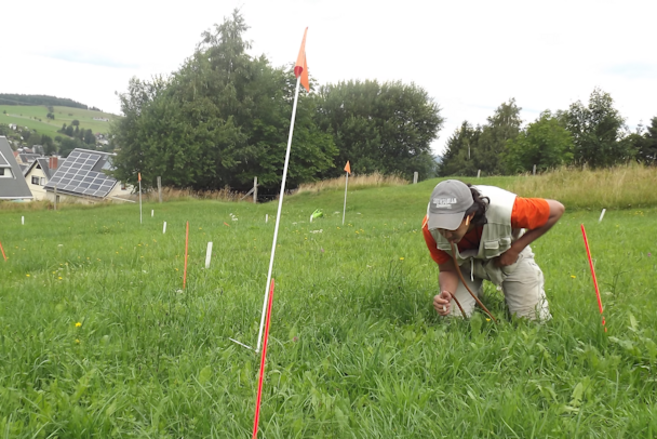
© Thünen-Institut/BD

Institut für
BD Biodiversität
Dr. Parastoo Mahdavi

Institut für Biodiversität
Bundesallee 6538116 Braunschweig
- Telefon
- +49 531 596 2502
- Fax
- +49 531 596 2599
- parastoo.mahdavi@thuenen.de
Arbeitsbereiche
- Agrarökologie
- Biodiversität
Forschungsschwerpunkte
- Vegetationsökologie
- Pflanzensoziologie
- Dünenökosystem
- Förderung der Biodiversität der Grünlandflächen
- Naturschutzforschung
Projekte
Beteiligt an
laufende Projekte
abgeschlossene Projekte
Ausbildung
- 2017: Ph.D. in Biologie, Vegetationsökologie, Georg-August-Universität Göttingen, Abt. Vegetationsanalyse & Phytodiversität Dissertation: “Vegetation and functional diversity of sand dune habitats between and within different bioclimatic regions”
- 2007: M.Sc. in Biologie der Pflanzen, Teheran Universität Thesis: “Phytosociological study of montane and submontane zones of Tuchal Mountain, N. Tehran”
- 2004: B.Sc. in Biologie der Pflanzen, Esfahan Universität
Werdegang
- Seit 2021: Wissenschaftliche Mitarbeiterin fürs Projekt ‚Agroecology for Europe‘ (AE4EU). Finanziert durch EU (Thünen Institut)
- 2018-2020: Wissenschaftliche Mitarbeiterin fürs Projekt ‚Biotopverbund Grasland‘. Finanziert durch DBU (Universität Oldenburg).
- 2017: Kartierung bei F.R.A.N.Z. Projekt: Artenvielfalt in der Agrarlandschaft (Universität Göttingen).
- 2015-2017: Wissenschaftliche Mitarbeiterin für verschiedene Lehrveranstaltungen, Abt. Vegetationsanalyse & Phytodiversität (Universität Göttingen).
- 2013-2015: Kartierung und Zustandsbewertung FFH-Lebensraumtypen der Natura 2000 Projekt auf Kreta, Griechenland (Universität Göttingen & Athen).
- 2011-2013: Wissenschaftliche Hilfskraft für Forschung und Lehre, Abt. Vegetationsanalyse & Phytodiversität (Universität Göttingen).
- 2009-2010: Kartierung in Südwest Iran (Khuzestan Provinz) und Zustandsbewertung der Vegetation auf der Petrochemie-Gelände (Teheran Universität).
- 2008: Phylogenetische Analyse der Gattung Heliotropium (Boraginaceae), Jodrell Laboratorium (Royal Botanic Gardens, Kew, London).
Publikationen
- Buchwald, R., Kretzschmar, N., Mahdavi, P. et al. (2021): Entwicklung und Umsetzung eines Grünland-Biotopverbundsystems in Agrarlandschaften der Landkreise Ammerland, Oldenburg und Wesermarsch. Abschlussbericht. Online verfügbar unter www.gruenlandzentrum.org/projekte/biotopverbund-grasland/
- Woesner, E. & Mahdavi P. (2021): Biotopverbund Grasland ein Netzwerk für mehr Artenvielfalt, Anleitung zur Entwicklung eines Biotopverbunds im Grasland. Broschüre, 1. Auflage. Klimaneutral Druckprodukt. Auch zum Download verfügbar unter www.gruenlandzentrum.org/projekte/biotopverbund-grasland/
- Tordoni, E., Bacaro, G., ..., Mahdavi, P. et al. (2020): Disentangling native and alien plant diversity in coastal sand dune ecosystems worldwide. J Veg. Sc. doi.org/10.1111/jvs.12961
- Bruelheide, H., Dengler, J., ..., Mahdavi, P. et al. (2019): sPlot – a new tool for global vegetation analyses. Journal of Vegetation Science. 30:161–186.
- Mahdavi, P. & Bergmeier, E. (2018): Distribution of C4 plants in sand habitats of different climatic regions. Folia Geobotanica. 53: 201-211.
- Mahdavi, P., Isermann M. & Bergmeier, E. (2017): Sand habitats across biogeographical regions at species, community and functional level. Phytocoenologia 47: 139-165.
- Mahdavi, P. & Bergmeier, E. (2016): Plant functional traits and diversity in sand dune ecosystems across different biogeographic regions. Acta Oecologica. 74: 37-45.
- Akhani, H., Mahdavi, P., Noroozi, J. & Zarrinpour, V. (2013): Vegetation patterns of the Irano-Turanian steppe along a 3000 m altitudinal gradients in the Alborz Mountains of Northern Iran. Folia Geobotanica. 48 (2): 229-255.
- Mahdavi, P. & Akhani, H. van der Maarel, E. (2013): Species diversity and life form patterns along 3000 m altitudinal gradient in the steppe vegetation of southern slopes of the Alborz Mountains, Iran. Folia Geobotanica. 48 (1): 7-22.
- Akhani, H., Malekmohammadi, M., Mahdavi, P. & Chase, M. W. (2013): Phylogenetic relationship based on nrDNA ITS sequences resolve species delimitation and relationship of the Irano-Turanian lineage of the genus Limonium (Plumbaginaceae). Botanical Journal of the Linnean Society. 171: 519-550.
- Akhani, H., Chatrenoor, T., Dehghani, M., Khoshravesh, R., Mahdavi, P. & Matinzadeh, Z. (2012) A new species of Bienertia (Chenopodiaceae) from Iranian salt deserts: a third species of the genus and discovery of a fourth terrestrial C4 plant without Kranz anatomy. Plant Biosystems. 146 (3): 550-559.
Nach oben

